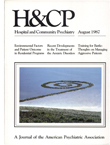Rehabilitation Outcome of Long-Term Hospital Patients Left Behind by Deinstitutionalization
Abstract
In 1979 a Massachusetts state hospital initiated a plan to transfer 54 long-term residents of two wards to the community through a series of increasingly independent working and living arrangements. This study assesses the patients' residential and vocational status and living skills over a five-year period beginning in February 1979. The patients demonstrated a significant increase in living independence, but only eight were able to live continuously in the community after their discharge, and 24 never left the hospital. Overall, vocational status did not improve, and living skills improved only slightly. Living skills and vocational status were predictive of living independence. The authors identify several steps that the mental health field should take to promote success among chronic patients, deinstitutionalized or not.
Access content
To read the fulltext, please use one of the options below to sign in or purchase access.- Personal login
- Institutional Login
- Sign in via OpenAthens
- Register for access
-
Please login/register if you wish to pair your device and check access availability.
Not a subscriber?
PsychiatryOnline subscription options offer access to the DSM-5 library, books, journals, CME, and patient resources. This all-in-one virtual library provides psychiatrists and mental health professionals with key resources for diagnosis, treatment, research, and professional development.
Need more help? PsychiatryOnline Customer Service may be reached by emailing [email protected] or by calling 800-368-5777 (in the U.S.) or 703-907-7322 (outside the U.S.).



